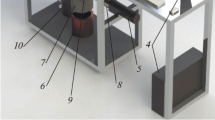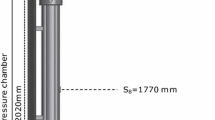Abstract
Equally spaced and uniform droplets are produced by a vibrating orifice and move away in a straight line. They intersect with an exactly equal string of droplets and collide one by one. With stroboscopic lighting and multiple exposures, they are photographed. Thus successive stages of the collision process are shown on a single photo. The droplets can be made to collide with or without angular momentum by adjusting the aim of the emitting orifices. The impacting speeds can be varied from 2.8 to 11.7 m/s. Droplet sizes from 70 to 200 μm are employed. Motions of the coalesced drop after the merging are bizarre and well-displayed. The results are important for spray modeling. When the streams of droplets merge at higher speeds, they may distort to the extent that the two streams of droplets merge to a single continuous sinuous stream.
Similar content being viewed by others
Abbreviations
- b :
-
collision parameter
- d :
-
diameter
- Δp :
-
pressure difference
- f :
-
frequency
- u :
-
impact velocity
- v :
-
droplet velocity
- V :
-
liquid feed rate
- x, y, z :
-
rectangular coordinates
- α :
-
angle between droplet stream and symmetry line
- G :
-
generator
- i :
-
initial, before the collision
- P :
-
particle
- T :
-
droplet
- 1, 2:
-
first and second droplet generator
References
Adam, J. R.; Lindblad, N. R.; Hendricks, C. D. 1968: The collision, coalescence and disruption of water droplets. J. Appl. Phys. 39, 5173–5180
Anders, K.; Frohn, A. 1984: Experimental investigation of droplet evaporation in a wide Knudsen number range. In: Proc. 14th. Int. Symp. on Rarefield Gas Dynamics (ed. Oguchi, H.), pp. 975–982, Tokyo: Univ. Press
Anders, K.; Roth, N.; Frohn, A. 1987: Study of the evaporation and combustion of droplets by a new optical sizing method. In: Proc. 6th International Congress on Applications of Lasers and Electro-Optics, Vol. 63, pp. 205–214. San Diego: L. I. A.
Arkhipov, V. A.; Ratanov, G. S.; Trofimov, V. F. 1978: Experimental investigation of the interaction of colliding droplets. Translation from Zhurnal prikladnoi Mekhaniki i Tekhnischeskoi Fiziki, No. 2 pp. 73–77
Jayaratne, O. W.; Mason, B. J. 1964: The coalescence and bouncing of water drops at an air/water interface. Proc. Roy. Soc. London Ser. A 280, 545–565
König, G.; Anders, K.; Frohn, A. 1986: A new light scattering technique to measure the diameter of periodically generated moving droplets. J. Aerosol Sci. 17, 157–167
König, G.; Frohn, A. 1985: Visualization of uniformly disintegrated liquid jets by a new observation technique. In: Proc. Flow Visualization III, (ed. Yang, W. J.) pp. 448–492. Washington: Hemisphere
Muntz, E. P.; Quian, S.-S.; Dixon, M. 1984: The injection of liquids into high vacuum for R. G. D. and space applications. In: Proc. 14th Int. Sym. on Rarefield Gas Dynamics (ed. Oguchi, H.), pp. 919–935, Univ. Press: Tokyo
Author information
Authors and Affiliations
Rights and permissions
About this article
Cite this article
Brenn, G., Frohn, A. Collision and merging of two equal droplets of propanol. Experiments in Fluids 7, 441–446 (1989). https://doi.org/10.1007/BF00187061
Received:
Issue Date:
DOI: https://doi.org/10.1007/BF00187061




